Any circuit of a 220 V energy-saving lamp is a collection of electronic components, each of which performs its own, very specific function. Small deviations from the basic design do not fundamentally affect its general characteristics. Basically, these differences are manifested in the variety of types of plinths, as well as in the power consumed by the product.
Types of energy saving lamps
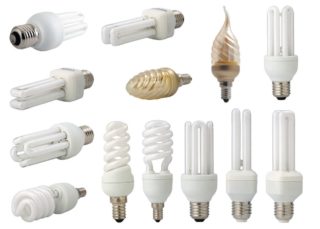
Known examples of energy-saving bulbs, which traditionally include LED, halogen and luminescent models, are classified according to the following criteria:
- type of base;
- luminescence temperature characteristic for each model;
- power consumption;
- flask shape.
By the type of base used to fix the bulbs in the lighting fixture, most of them are divided into threaded and pin products.
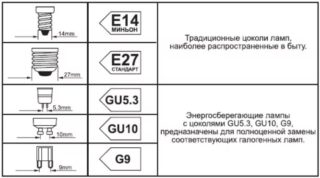
The most common in everyday life are threaded socles, which are screwed into standard sockets of various diameters (as for incandescent lamps).
In the description of the product, this element is designated by the letter "E" followed by a number corresponding to the diameter in millimeters. The standard size of most of the lamps produced is E27, and products with a diameter of E14 are installed in luminaires or sconces.
Threaded caps are most often used in lamps intended for street lighting (in DRL and sodium). Pin-type products are only suitable for luminaires of special design and increased power. They have different modifications, differing in the number of pins (two or four), and their connectors are marked with the letter "G" with a corresponding numerical symbol.
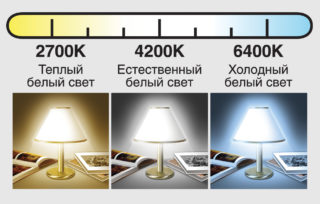
Depending on the temperature of the glow, measured in Kelvin, each sample of the energy-saving lamp emits light of “its own” shade.
- Warm light with an index of 2700 K, outwardly resembling a yellow tint. It is very similar to the glow of conventional incandescent bulbs.
- Natural white with a temperature of 4200 K. These are the so-called "fluorescent lamps" with a neutral color.
- "Cold" glow, like a shade of white with a temperature value of 6400 K.
Cold light is close to the blue spectrum and resembles a slightly bluish color. Bulbs with such a glow are most often used in industrial premises and are designed for a power of 65 watts or more.
Energy-saving products differ in the shape of the bulb: spiral, arched and tubular.
Work principles
When compared with the same indicator for incandescent lamps of similar power, the luminous efficiency in this case is noticeably higher. The disadvantage of such products is the impossibility of direct connection to the 220 volt power circuit.As a result, it is mandatory to use a special converting device called electronic ballast.
LL device
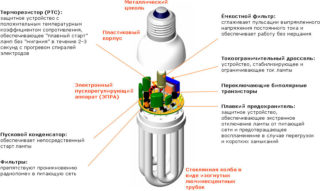
The electronic circuit of the lamp is located under the external structural elements - it is designated as an electronic ballast or ballast. This unit in its entirety is not present in every model of the "housekeeper". In the same place where the starting regulator is installed in the classic configuration, the economy lamp circuit consists of the following main modules and parts:
- starting capacitor, providing a powerful pulse necessary to start the circuit;
- a surge protector that allows you to reduce the level of radio frequency interference to an acceptable level - to get rid of the flickering effect;
- a capacitive filter that smooths out the ripple of the current component;
- current limiting choke required for overload protection;
- bipolar transistors and driver.
The light bulb circuit contains a fuse that protects it from failure during sudden voltage surges, and a number of additional elements.
Components of the ballast diagram and features of its operation
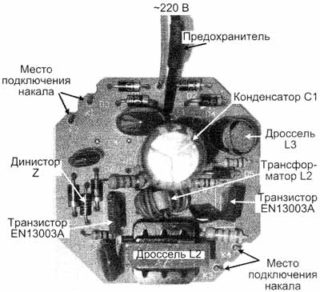
The electronic ballast includes a driver, a transistor switch, and an output transformer with resonant triggering elements. The order of work of this block:
- The current pulse formed in the master module enters the base of the transistor and leads to its opening.
- Immediately after this, the capacitor is charged, the speed of which is determined by the additional elements of the circuit.
- From the output of the transistor switch, the pulses are fed to a small-sized transformer.
- From its secondary winding through a resonant circuit with a capacitor, a reduced pulse voltage is supplied to the lamp contacts.
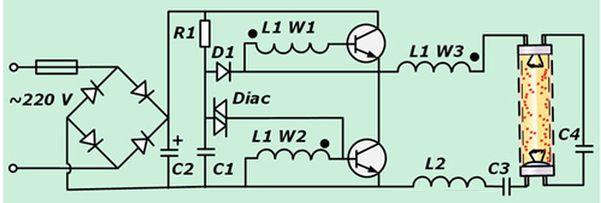
The glow formed in the tube is characterized by its inherent resonant frequency, which depends on the capacitance of the capacitor connected in parallel. At the initial moment during ignition, the value of the impulses reaches up to 600 volts, which forces the use of special measures of protection against overvoltage. This can be done due to the use of a shunt capacitor in the circuit, which allows immediately after the breakdown to "break" the resonance and transfer the lamp to a working state with a constant glow. Its interruption is possible only after the operation of the switch installed in the lighting device itself.
Restoration procedure and the need for repair
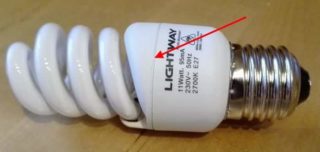
In the event of a malfunction in an energy-saving light bulb, disassemble it into its component parts. To do this, you will have to do the following operations:
- Disconnect the two assembly halves and then remove the flask.
- By means of an ohmmeter charged with a fresh battery, "ring out" both heating coils for the absence of a break in them.
- If you find it, you can try to use at least one of them.
- To do this, it is necessary to bridge the burned-out branch with a 22 Ohm resistor and a power of about 1-2 watts.
When carrying out this operation, it will be necessary to dismantle the shunt spiral diode, if it is in the circuit.
All these actions are valid for energy-saving lamp circuits for 20 W, no more.
If the spirals in lighting products with a power of more than 30 watts burn out, the key transistor will most likely fail. To restore the functionality of the circuit, replace them with new parts. In a single case, repairing a product that costs a penny does not make sense - it is much easier to buy new ballast.
Danger of LL and recommendations for use
- exposure to UV radiation is harmful to the skin and leads to early aging;
- possible disorders such as allergies, eczema and psoriasis;
- often ultraviolet light causes epileptic seizures, migraines, and also worsens the general condition of the body.
The strength of hazardous radiation depends on the location of the LL and the distance to the irradiated object. In this regard, they are not recommended for use in table-mounted or wall-mounted luminaires. This is all the more important when you take into account the danger of exposure to radiation on human vision.
An example of a practically safe emitter is the LBO O8M 36 N lamp with an electrical diagram of which can be found in any reference book. With the timely adoption of organizational protective measures, the operation of energy-saving emitters, as a rule, does not cause any particular difficulties.

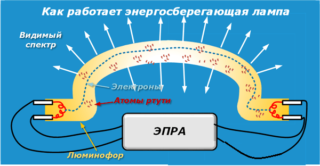
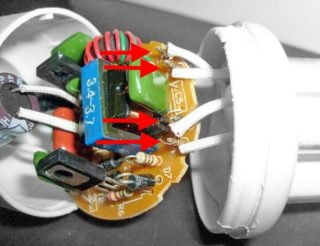
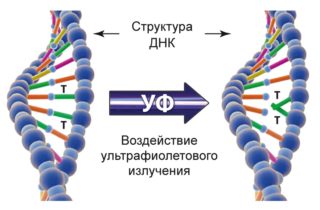








Author Read GOST 15049-81 Electric lamps. Terms and definitions, there is no such thing as "energy saving lamps". There are all sorts, but there are no energy-saving ones, all lamps that consume less energy than incandescent lamps, including gas-discharge fluorescent and LED lamps, can be classified as energy-saving ones. Those about which you write refer to gas-discharge fluorescent lamps.